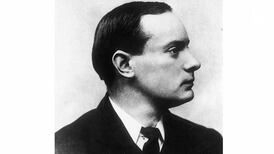The Gifford sisters are well known in Irish history, especially Grace, who married 1916 Proclamation signatory Joseph Plunkett on the eve of his execution, and to a lesser extent Muriel, who was married to another executed 1916 leader, Thomas MacDonagh. The youngest of the sisters, Sydney, who was a journalist, broadcaster and labour and nationalist activist, died 50 years ago on September 15th, 1974.
Sydney Madge Gifford was born on August 3rd, 1889, at Temple Villas, Rathmines, Dublin, the youngest of 12 children of Frederick Gifford, a prosperous solicitor, and Isabella Burton. Her father was a Catholic and her mother a Protestant and all the children were raised as Protestants. Although the parents were conservative and unionist, at least four of the daughters became involved in radical and nationalist politics; interestingly, and perhaps curiously, none of the boys did.
She attended Alexandra College, then located in Earlsfort Terrace, and afterwards studied in the Leinster School of Music. Through the poet and writer Seumas O’Sullivan, whom she met in his father’s pharmacy on Rathmines Road, she was introduced to nationalist newspapers and began contributing articles to them, especially Arthur Griffith’s Sinn Féin journal.
As a result of visits to the home of George Russell (AE), she met many of the writers who were part of the Irish literary revival.
Far away, so close – Fionnuala Ward on measuring distance
The Derry man who influenced George Washington and Alexander Hamilton - Brian Maye on Hercules Mulligan
The BBC’s national question: Frank McNally on Edna O’Brien and ‘the North of Ireland’
Dictionary on the Double – Frank McNally on the enduring literary life of Patrick Dinneen
She wrote under the pseudonym “John Brennan”, chosen, according to herself, because the name sounded like that of a “strong Wexford farmer”, which she felt would be more likely to command respect than her own name, and it had the added advantage of keeping the more conservative members of her family unaware of her writing career.
Joining Maud Gonne’s Inghinidhe na hÉireann, she helped in the launch of its newspaper, Bean na hÉireann, in 1908, to which she contributed extensively. Her articles covered a range of topics, from the poor treatment of women in the workplace to fashion and gardening columns. The organisation launched a scheme in 1910 to provide school meals for poor Dublin children, in which she was also deeply involved. The following year she was appointed a member of the Sinn Féin executive.
By joining the Irish Women’s Franchise League, she involved herself in the suffrage campaign, participating in league activities and contributing to its Irish Citizen newspaper. Her sister Muriel’s marriage to Thomas MacDonagh further strengthened her radicalism and she afterwards contributed articles to the Irish Republican Brotherhood’s paper, Irish Freedom. In June 1914, she departed for New York, believing that America would provide greater opportunities for a woman journalist.
The old Fenian Tom Clarke, who tried to discourage her from going to America, gave her a letter of introduction to John Devoy, leader of Clan na Gael, the American wing of the IRB, but she found Devoy unhelpful and didn’t get work with his Gaelic American newspaper.
However, other Irish contacts in America were more helpful, especially Padraic and Mary Colum, whom she’d met in Ireland through Thomas MacDonagh, and they introduced her to leading Irish-Americans. Among her activities was campaigning to keep America out of the war in Europe and she helped James Connolly’s daughter Nora to make contact with German diplomats in the US. She set up the first American branch of Cumann na mBan, the women’s auxiliary body to the Irish Volunteers, and contributed to newspapers such as the New York Sun and Patrick Ford’s Irish World, which switched allegiance from the Irish Parliamentary Party to Sinn Féin as a result of her influence.
Her sisters Muriel MacDonagh and Grace Plunkett were widowed as a result of the 1916 Rising and another sister, Nellie, actually participated in the Rising, serving with the St Stephen’s Green division of the Irish Citizen Army. Sydney was unable to return to Ireland as the British authorities refused her a passport, so she assisted the continuing independence campaign however she could, running the pro-Sinn Féin Progressive League premises in New York. While in America, she married Arpad Czira, a Hungarian immigrant, and following a period working in Philadelphia for Patrick McGarrity’s Irish Press, she returned to Ireland in 1922 with her infant son Finian, by which time her husband had already returned to Hungary.
She opposed the Anglo-Irish Treaty and was active in the Women’s Prisoners’ Defence League, which protested the treatment of anti-Treaty prisoners during the Civil War. Her journalism career continued and she presented programmes on the newly launched 2RN (later Radio Éireann) station. Her broadcasting stint was interrupted for a time in the late 1920 due to differences with her government employers but she was reinstated in 1932. Following the second World War, she and Dorothy Macardle brought German refugee children to Ireland.
In the 1950s, this newspaper published some of her personal reminiscences, especially of her former colleagues in the independence struggle, which she found amusingly ironic because for long The Irish Times frowned upon the activities of such people.
These reminiscences were published posthumously in book form in the year of her death, under the title The Years Flew By; it provides valuable personal insights into some of the major figures in the struggle for Irish freedom.















